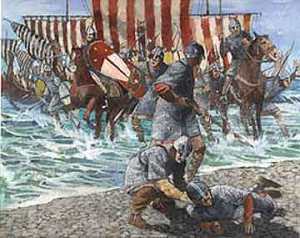The Viking Connection
By 847 C.E. it became clear that the Viking invaders of Ireland had developed political ambitions beyond the sporadic raiding of the previous three decades. Within one year the Irish won an unprecedented four victories over the Vikings which effectively expelled a tremendous portion of the invaders from Ireland (Graham-Campbell, 1989). That same year in Brittany Viking raiders began an invasion of the mainland peninsula and won three decisive victories over the Bretons (Cassard, 1996). Current scholarship makes no connection between the events in Brittany and Ireland in 847 C.E., but evidence exists to link these events more closely than previously acknowledged. It begins in 799 C.E. with a raid on the island of Noirmoutier found south of the mouth of the Loire River. The monks from the monastery of Saint Philbert fled the island, but returned the following year. In 834 C.E., the monks abandoned the island definitively due to the persistence of the summer raids by Vikings (Delhommeau, 1999). This allowed the Vikings to use the island as a base beginning in 837 C.E. from which they could raid the Loire River Valley. If we consider the larger scope of events in 9th century Europe, Noirmoutier appears to be a rather small and insignificant chapter in the Viking Age. However, the resources of the island (salt), and by extension of the region of Brittany, attracted repeated raids and invasion attempts. Salt was after all a necessary resource for any army of the time, and the Vikings were no exception.
When the Bretons under the command of Barbe-Torte retook the city of Nantes in the 10th century, they found a derelict city which should have been a flourishing trade center. This is indicative that the Vikings had no long term settlement ambitions in Brittany, and that their assets in the region were for purely military reasons (Price, 1989). Specifically, the Vikings held parts of Brittany and Noirmoutier for the acquisition of two important resources: salt and wine. Both are needed in war; and the ambitious warlord Turgeis necessitated all the help he could muster to see through his plans to conquer Ireland. The need for resources, and the lack of permanent interest in Brittany point to an important connection between the Vikings in France and Ireland who may have supported one another during military campaigns to ensure their mutual interests.
C.J. Adrien’s second novel — titled In The Raven’s Wake and due to be released in 2015 — will make use of exclusive research done on the connection between the Vikings of Ireland and Brittany. The protagonist of Adrien’s debut novel The Line of His People will be swept out to sea to Ireland where he will again fight to survive in one of the most violent periods of European history. Haven’t read the first novel? Get it HERE for $0.99.
Bibliography:
Cassard, Jean-Christophe. Le Siècle Des Vikings En Bretagne. Paris: Editions Jean-Paul Gisserot, 1996.
D’Haenens, Albert. Les Invasions Normandes, une Catastrophe?. Paris, 1970.
Delhommeau, Louis. Ermentaire: Vie et Miracles de Saint Philbert. District de L’isle de Noirmoutier, 1999.
Graham-Campbell, J. The Viking World, (rev. ed.). London, 1989.
Hall, R. A. Viking Age Archeology in Britain and Ireland. Princes Risborough, 1990.
Price, Neil S. The Vikings in Brittany. London: Viking Society For Northern Research, University College London, 1989.
Smyth, A.P. Scandinavian York and Dublin, (2 Vols.). Dublin, 1975-79.






